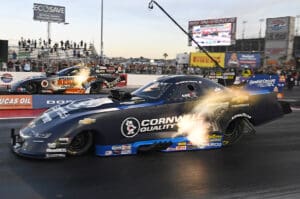 Roy Hill epitomized the spirit of the Southern born and bred Pro Stock driver to the point he carried the nickname “Hillbilly.”
Roy Hill epitomized the spirit of the Southern born and bred Pro Stock driver to the point he carried the nickname “Hillbilly.”
Hill, of Sophia, NC, was proud of his heritage and most of his
background was closely tied to the NASCAR community, before the
roundy-round sanctioning body became the 800-pound gorilla. It wasn’t
hard to see a Hill Mopar in those early days – they sported Petty Blue
and orange paint schemes.
Hill never won a world championship drag racing, but came close on many occasions. He raced IHRA Pro Stock from Day One in 1971.
Hill is credited with 33 final round appearances, 26 of which came
after the IHRA converted to the mountain motor format in 1977. He was a
player in the new format from the first race reaching the finals four
times and winning twice.
 Roy Hill epitomized the spirit of the Southern born and bred Pro Stock driver to the point he carried the nickname “Hillbilly.”
Roy Hill epitomized the spirit of the Southern born and bred Pro Stock driver to the point he carried the nickname “Hillbilly.”
Hill, of Sophia, NC, was proud of his heritage and most of his background was closely tied to the NASCAR community, before the roundy-round sanctioning body became the 800-pound gorilla. It wasn’t hard to see a Hill Mopar in those early days – they sported Petty Blue and orange paint schemes.
Hill never won a world championship drag racing, but came close on many occasions. He raced IHRA Pro Stock from Day One in 1971.
Hill is credited with 33 final round appearances, 26 of which came after the IHRA converted to the mountain motor format in 1977. He was a player in the new format from the first race reaching the finals four times and winning twice.
The switch to the mountain motors fell right into Hill’s favor because of the extreme restrictions forced upon his beloved Hemi combination.
“I was all for the switch,” Hill said. “I had to carry all of the weight for the big Hemi. So when they said 2350 pounds across the board, I got to take weight out.”
Hill drove all the way to the final round of the first event at Darlington Dragway before losing to Harold Denton.
 “I was shaking my butt off with my new car,” Hill said of the Plymouth Arrow he drove that weekend. “I put on my old tires and wheels from the old Duster and it went just as smooth as you could get. I made a dumb decision before the final round and went back to my new and shiny wheels before the finals so the car would look good in the finals – and I went out and shook my brains out.”
“I was shaking my butt off with my new car,” Hill said of the Plymouth Arrow he drove that weekend. “I put on my old tires and wheels from the old Duster and it went just as smooth as you could get. I made a dumb decision before the final round and went back to my new and shiny wheels before the finals so the car would look good in the finals – and I went out and shook my brains out.”
Hill has ten IHRA Pro Stock top ten point finishes to his credit with four third places, 2 fourths, 3 fifths and one sixth.
Hill was an innovator. Some of his plans worked and others didn’t.
Hill once introduced a Mercury Topaz into the class that featured a method of capturing the air underneath the car and channeling it through the rear window. The goal was to create more downforce.
“It about killed me, that’s how well it worked,” Hill said, a layer of sarcasm in his voice. “The car was built in Florida by a guy in the limo business. It had a lot of neat ideas, none of which worked. The air would come through the tunnel and lift the rear wheels in the air.”
The early days of the class were special for Hill. He said they built the foundation for his career and what would later become a successful driving school business.
“We were making about 1,000 horsepower in those early days with the big motors, so it fit in well with what we were doing,” Hill said. “We had just come out with the six-lever clutch and it made those mountain motor cars really run well. Today everybody uses 6 to 9 lever clutches. The Pro Stock class is now running about 1,300 horsepower. But the gains we made early on were huge. Our clutch knowledge wasn’t that strong but I think my team had an advantage in that area. That came from years and years of traveling up and down those small race tracks.”







































